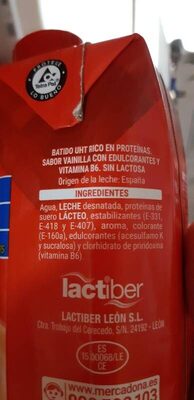Bebida whey proteínas - Hacendado - 330 ml
Aquesta pàgina del producte no està completa. Podeu ajudar a completar-la editant-la i afegint-hi més dades a partir de les fotos ja disponibles, o fent-ne més amb l'aplicació de androide o iPhone / iPad. Gràcies!
×
Codi de barres: 8480000166715 (EAN / EAN-13)
Quantitat: 330 ml
Marques: Hacendado
Categories: Begudes, Productes làctics, Begudes làcties, Begudes ensucrades artificialment
Etiquetes, certificacions, premis: Sense lactosa
Origen dels ingredients: Espanya
Llocs de fabricació o processament: León
Codi de traçabilitat: ES 15.00068/LE CE
Botigues: Mercadona, Hacendado
Països on es va vendre: Espanya
Matching with your preferences
Entorn
Empaquetament
Transport
Report a problem
Fonts de dades
Producte afegit per elcoco
Última modificació de la pàgina del producte per kiliweb.
La pàgina del producte, també editada per ecoscore-impact-estimator, elcoco.c6ef91e23a271a71142bda6a78f581df, hansuk, maylord, musarana, openfoodfacts-contributors, peli309, roboto-app, yuka.WWZndUxyZ0x0dEkzc3ZBYXpCZmx3OUJ6eXBLekFsM3FKOUZBSUE9PQ, yuka.sY2b0xO6T85zoF3NwEKvlmBHCNH7_Q3PGzvWmheA1_m1d7_Hc9Z1yIrQYqo, yuka.sY2b0xO6T85zoF3NwEKvlmJqesTGqzmVaQDTv0fX_86lH5LmY4l_-5PAMqg.










